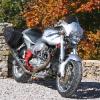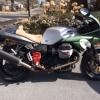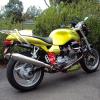Leaderboard
Popular Content
Showing content with the highest reputation on 04/01/2024 in all areas
-
4 points
-
As mentioned, there isn't going to be a number printed on the spring that corelates to the riders weight. There are too many other variables involved to make that possible. The spring only knows its own rate, as well as its length. It doesn't know the ratio of rear suspension travel to shock / spring travel. If you measure and set the sag of the bike with you sitting on it, then measure how much sag there is without you sitting on it, that will tell you how the rate of the spring is. Too much sag without you on the bike after setting the sag right with you on the bike means the spring is too stiff. Too little sag without you on it after setting the sag correctly with you on it means the spring is too soft. That can seem backwards, but it is right. Too little sag without you on the bike means you had to add too much preload to the spring to get the sag with you on the bike correct. That excessive preload means that without you on the bike the bike sags very little. The opposite can also be true, too stiff a spring means you don't need much preload to get sag right with you on the bike, so with so little preload the bike will sag too much without you on the bike. Different people have slightly different versions of the target numbers for sag, but generally you want somewhere between 25 - 30 percent of total travel use up by sag with you on the bike, and only 10 - 15 percent sag under just the weight of the bike. Some people like a little more sag, some like less. One thing to keep in mind, more sag with you on the bike does not mean the spring is softer, only that it has less preload. With less preload, the suspension rides lower in its travel, that can be good, or it can make for a harsh ride if it leads to more bottoming of the suspension. I think you want the suspension to ride high enough that the suspension doesn't bottom very often, if at all.3 points
-
What fork seals are you using? I use these Ariete ARI.023 and the Y type dust seals with the spring on the outside. The dust seal will be something like 40x54.4x 4.6x14. It's written on the seal so you can X ref with Ariete p/n. I also use a very thin home made plastic sleeve for seal protection on the fork slider at the bush end to fit the new seal onto the slider. Make sure you tap the bush in before the seal and spacer. Don't fit them together. The seal should just push into the fork stanchion with a firm downward push on the seal driving tool. No need to hammer anything. Make sure your seal driver isn't a style that pushes down on the critical sealing lip area of the seal. I have a seal driver that I can't use on some seal s even though the driver is the correct size because it's OD isn't quite enough to not interfere with the sealing lip area. Phil3 points
-
As a guy whose had a brief track record of being a walking talking motorcycle crash test dummy, I will vouch that the armor used in jackets works. I should probably be dead or at least crippled. Why am I not? Helmets and body armor. I though those Dianese titanium shoulder guards were a gimmick.. I thought that till I highsided with a 900lbs Triumph Rocket. Not just did that helmet work by protecting my head as I proceded to land on a street like a lawn dart, but them foam guards in the forearms and shoulders buffered the impact by preventing my left forearm and shoulder from shattering like a ceramic vase and that titanium shoulder absorbed impact and protected me as I slid about 70ft. I walked away with a C6-C7 ruptured disc and a torn labrum in the shoulder. Not bad, right? Believe what you want. We are adults. I'll grab a helmet, gloves and a jacket. Y'all wanna hear my glove rant???? Got pics in my phone for that one..2 points
-
No. I always wear gloves, and a jacket that claims to be a motorcycle jacket. I don't really know how much protection the waxed cotton jacket really offers, but if I think I might be on a ride where I might get a bit silly, I wear the leathers. And always a full-face helmet. I saw one a couple of years before I started riding myself that had abrasive damage on the chin-piece. That was enough to convince me that a jet helmet is not such a great idea. When I had "my accident" in 2017 I was wearing a full-face helmet, thick gloves, and leather jacket and pants without armour. The helmet lost about 3mm of material just below the visor above my right cheek-bone. The leathers got some nasty abrasions on the front of the right shoulder, and on the left knee. The broken bones were in the left hand from the impact of the handle-bar against the hand, and in the right forefinger where something (probably the wing mirror of the car that took me out) went through the glove and the finger. Body armour wouldn't have stopped any of that. That all doesn't mean I consider armour to be not necessary. I got lucky in that accident, it could have been lots worse. What I'm getting at is more like "take precautions, but the most important one is to not have an accident". Armour might help, or it might not. My leather stuff doesn't have any, and I took it out of my ventilated textile summer jacket because it compromised the ventilation. I choose to take the risk, and concentrate on not having another accident. But always some kind of motorcycle jacket, full-face helmet and gloves. If I'm going out to play, leather jacket and pants.2 points
-
From what the Beemer Shop told me(Wilburs dealer), you take full wheel travel of 128mm on a V11, measure that from two reference points. That will be with rear in the air at full extension. Then measure same distances with you sitting on it. Your target is 30% of the first number. From there you adjust to get to that 30% number. I wont have time to do that for a couple weeks...life is getting in the way again.2 points
-
I was merely discussing beer from a purely academical point of view. I was never a beer drinker, and I still don't qualify for one. This was more about Beer tradition between Germany and the rest of Europe. Also, when I say Europe, I am referring to the Maastricht treaty signed in 1992, effective 1993. The 12 original countries that signed the treaty. Same as in the USA, with the 13 original states. 12 Stars on the European flag, and 13 stripes on the US flag. My passion was/is in the wine, and I participated to two harvests from grapes cutting to wine making. First with traditional wine, second with sparkling wine in the region commonly known as Champagne. I was blessed in having the opportunity to continue my journey by working in several countries with a wine tradition. That's my end of it. Texas makes wine too, but I am yet to find one that I really like.2 points
-
Thread drift killer; O.P. says: Problem solved. After hose job last week, did valve job yesterday (a little tight, intake closer to American setting and exhaust gaps were no bigger). Changed to closer to "world spec". Actually seems quieter/smoother now. Topped off engine and transmission oil and got out for a ride today. Kept it a little less spirited to test. All good. Enjoyed greatly! Thanks, again, to all who post on the forum.2 points
-
2 points
-
No worries mate, I got mine neary 30 years ago. Only if you want to drink more beer than you can get in within the 90 day standard Schengen area tourist visa. So @docc , come on over. I'll buy you one or three.2 points
-
Returning, in some convoluted way, to the matter of things German(ic), I found it most interesting that Mexican beer, and many from Texas, owe their origins to the Germans (and "Austrians") that emigrated here under Emperor Maximillian. Max did not stay, but the beer did! One of my current favorites: Shiner Bock (Shiner, Texas) from the Spoetzl Brewery. ("Spötzl?")1 point
-
You can largely disregard the lower number in so far as you should aim for the lowest possible for a Full Synthetic group 4 oil. The "it's too thin" thing is the opinion of people with no idea about oil. To get this point straight in you head and a perspective on it think of it this way. A 0W-40 oil is still a LOT more viscous at room temperature (so the 0 end of the scale) than it is at 100deg C ( the 40 end of the scale) or engine operating temp where the engine is designed to produce maximum rated load and power and the oil is designed to provide lubrication and cooling so how can a 0W oil be "too thin"? Answer, it isn't. It's true that the wider the spread of viscosity even in a Fully synthetic group 4 oil the greater the additives with regards to maintaining the VI but it's nothing compared to older mineral based oils which always started with a higher viscosity base oil to provide a safety floor viscosity wise for those that don't change their oil. I run my Daytona engine on 10W-60 for two reqasons, one because "some" of these engines have oil pressure issues at idle in traffic at high ambient temps. It's just a little headroom for these conditions here. The second is because it has higher zink levels for the flat tappet lifters. Should it be changed more regularly than a 10W-40 oil, probably. Like you I wanted to use a single oil in all my vehicles and I chose Mobil1 0W-40 and used it for years in everything including in my V11 Sport with the original 2 valve engine. Worked perfectly and didn't have any issues with oil in the airbox etc or OP light at idle. The SP rating is the latest spec but not relevant to our bikes because like the interim SN+ which was a fill in spec until the SP grading was released these latest 2 specs are primarily about protecting direct injection engines from LSPI nothing more. Grisos went to a 10W-60 oil ostensibly to help out with oil temp issues in the oil cooling galleries around the exhaust ports these engines use but I never saw the sense in this. I've never been able to find any data on the difference between a 60 weight oils ability to absorb and carry away heat over the capacity in the same circumstances as 40 weight but I can say for sure that a 60 weight would not flow as well as a 40 weight oil in those conditions and when you are trying to carry away heat from a hot source what you want is more flow not less from a heavier weight oil. I've spoken to powerplant engineers in aviation and at GM personally that had almost no detailed knowledge about engine oils believe it or not. I wouldn't be surprised if Guzzi wasn't pretty much the same. BTW I've never considered using Motul oils because they don't release a detailed enough TDS listing zink levels and anti wear, anti oxidation and detergent information. Phil1 point
-
Yes. Always gloves. They start saving skin when you mess up putting the side-stand down, and never stop being a good idea.1 point
-
All of my street-riding jackets have these, and my dirt-riding clothes are damn near bubble wrap at this point. Without them, I'd feel naked, and not nearly as muscular. After watching this video (huge fan of F9) I disagree. If I bang my elbow into the wall with or without, I already know what one will hurt far more. It would be nice to have less weight in the jacket though, cooler as well.1 point
-
How did the fix work on the turn signals? Seems like the would be some universal ones that would work. Finally got started on my tuning work, only a few runs so far, pretty rich, saw some AFR in the 10's and 11's cruising on flat ground around 4k. I'm running the Mistral front and center sections on mine, made some significant differences on balance from left to right.1 point
-
Have those bulbs in my 03, 04, V11 and patterns is like a regular H4 halogen, only brighter. 1100 Sport needed some grinding on the bulb to get the lock working. Don’t fit in my 01 Greenie steel housing. My 99 has an aftermarket smaller housing with enough length to fit. Don’t ride a lot after dark no more, but no dought, BETTER. Cheers Tom.1 point
-
In my opinion, which is worth what you paid for it, there is some wiggle room on oil viscosity but only within reason. And that wiggle room is affected by the environment the motor is running in (warmer climate vs colder climate) That is why on many oil recommendation sheets they list more then 1 oil viscosity, depending on temperature it is being operated in. I am not sure I would run a 10w-60 in our V11. But I doubt it would be a problem, especially once it has a fair amount of miles on it. I would not use it because I am not a fan of 10w-60 oils, they are in essence a 10 weight oil with a lot of viscosity modifiers added, and those tend to break down faster. I would rather use an oil that doesn't rely as much on viscosity modifiers. But that is really just my personal preference. If you are already running 10w-60 oils you are probably fine with it. Also, for the Griso 1100 it started with calling for 5w-40 and at some point later they changed the oil spec to 10w-60 as I recall. I really don't think anything changed.1 point
-
1 point
-
1 point
-
Sadly, my kids and I usually start school about two weeks prior to the Raid. May have to be retired or get fired (order not necessarily reflective of preference) before I can make it down there in early September.1 point
-
1 point
-
Less than six months out, now @gstallons . . . Time to put yer-anus in gear!1 point
-
I hope someone has some good advice on getting your forks to seal. Back in the shop, I see I used 100 mm air gap on my early Sport 40mm Marzocchi, corresponding to 330 ml fluid per leg.1 point
-
Silly I know, but I wanted to say thanks to all of you. It's nice to have similar passionate people to discuss details that only we'd understand. Roll on!1 point
-
Not silly at all. There is not enough of that positive stuff in the world. And yes, the forum is fantastic. I'm glad I found it.1 point
-
My rejuvenated Tachometer and Speedometer are coming back from Germany this week. Once it is back together, I will be using it to do the Motorcycle Grand Tour of Texas stops.1 point
-
1 point











